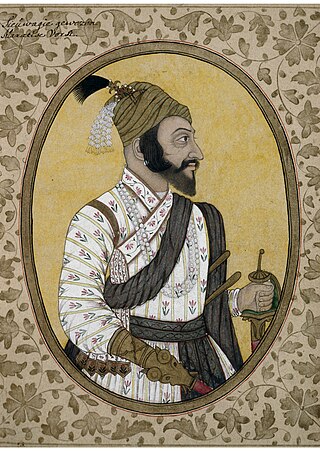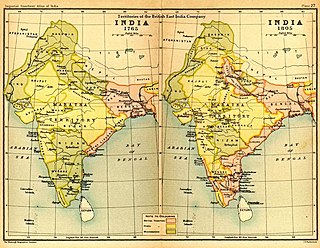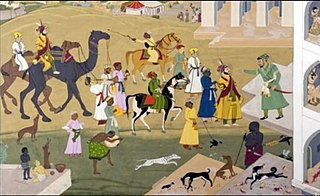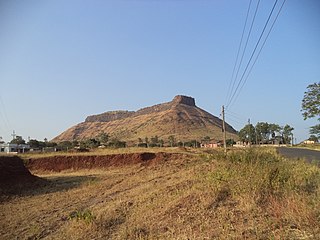
Shivaji I was an Indian ruler and a member of the Bhonsle Dynasty. Shivaji carved out his own independent kingdom from the declining Adilshahi Sultanate of Bijapur that formed the genesis of the Maratha Empire. In 1674, he was formally crowned the Chhatrapati of his realm at Raigad Fort.

Sambhaji, also known as Shambhuraje was the second Chhatrapati of the Maratha Empire, ruling from 1681 to 1689. He was the eldest son of Shivaji, the founder of the Maratha Empire. Sambhaji's rule was largely shaped by the ongoing wars between the Maratha Empire and the Mughal Empire, as well as other neighbouring powers such as the Abyssinians of Janjira, Wadiyars of Mysore and the Portuguese Empire in Goa. After Sambhaji's execution by Aurangzeb, his brother Rajaram I succeeded him as the next Chhatrapati and continued the Mughal–Maratha Wars.

Mir Qamar-ud-din Khan Siddiqi also known as Chin Qilich Qamaruddin Khan, Nizam-ul-Mulk, Asaf Jah and Nizam I, was the first Nizam of Hyderabad. He was married to the daughter of a Syed nobleman of Gulbarga. He began his career as a favourite of the Mughal emperor Aurangzeb, who made him a general. Following the death of Aurangzeb in 1707, Asaf Jah refused to favour any one of Aurangzeb's warring sons and as such remained neutral. When Aurangzeb's third son Bahadur Shah ultimately emerged victorious, Asaf Jah was rotated as governor of multiple Mughal provinces until 1714, when he was created Viceroy of the Deccan with authority over six Mughal provinces in southern India from 1714 to 1719. From 1719 onwards he was involved in combating the intrigues of the Sayyid Brothers. From 1720 to 1722 he helped the new Mughal emperor Muhammad Shah eliminate the Sayyed brothers and was rewarded by being elevated to the grand viziership from 1722 to 1724. He also engaged in military conflict against Bajirao I in Battle of Palkhed and Battle of Bhopal in which he was severely defeated and had to sue for peace.

The Deccan wars were a series of military conflicts between the Mughal Empire and the descendants of the Maratha ruler Shivaji from the time of Shivaji's death in 1680 until the death of Emperor Aurangzeb in 1707. Shivaji was a central figure in what has been called "the Maratha insurgency" against the Mughal state. Both he and his son, Sambhaji, or Shambuji, typically, alternated between rebellion against the Mughal state and service to the Mughal sovereign in an official capacity. It was common practice in late 17th-century India for members of a ruling family of a small principality to both collaborate with the Mughals and rebel.

The Maratha Conquests were a series of conquests in the Indian subcontinent which led to the building of the Maratha Empire. These conquests were started by Shivaji in 1659, from the victory at the Battle of Pratapgad against Bijapur. The expansion of the empire was limited and interrupted by the Mughal conquests of south India by Mughal ruler Aurangzeb until he eventually died in 1707 in Deccan itself. Marathas were forced to defend their territories against the overwhelmingly strong Mughal army in the 27 years long Deccan wars. They were able to defend their territories and gain an upper hand over Mughals in the sustained conflict.

Muhammad Ismail, known by his title Zulfiqar Khan, was a leading noble and military general of the Mughal Empire. His father was Asad Khan, wazir to Mughal emperor Aurangzeb. During Aurangzeb's reign, Zulfiqar Khan led several military campaigns in pursuit of the emperor's ambitions in the Deccan and South India, notable of which is the Siege of Jinji. He held the post of mir bakhshi, appointed towards the later part of Aurangzeb's reign, and was made governor of the Deccan by emperor Bahadur Shah I. These positions helped make Zulfiqar Khan the most powerful noble in the empire by the early 1700s.

The siege of Bijapur began in March 1685 and ended in September 1686 with a Mughal victory. The siege began when Aurangzeb dispatched his son, Muhammad Azam Shah, with a force of nearly 50,000 men to capture Bijapur Fort and defeat Sikandar Adil Shah, the then ruler of Bijapur, who refused to be a vassal of the Mughal Empire. The siege of Bijapur was among the longest military engagements of the Mughals, lasting more than 15 months until Aurangzeb personally arrived to organize a victory.

The siege of Jinji,, began when the Mughal Emperor Aurangzeb appointed Zulfiqar Ali Khan as the Nawab of the Carnatic and dispatched him to besiege and capture Jinji Fort, which had been sacked and captured by Maratha Empire troops led by Rajaram, they had also ambushed and killed about 300 Mughal Sowars in the Carnatic. The Mughal Emperor Aurangzeb then ordered Ghazi ud-Din Khan Feroze Jung I to protect the supply routes leading to Jinji Fort and to support and provide reinforcements to Zulfiqar Ali Khan when needed.

Muqarrab Khan of Golconda, also known as Khan Zaman Fath Jang Dakhini, was an Indian Deccani Muslim, who was the most experienced commander of Qutb Shahi Dynasty, during the reign of Abul Hasan Qutb Shah. He is known for betraying Abul Hasan Qutb Shah during Siege of Golconda. He arrested Maratha Emperor Sambhaji at Sangameshwar.
The Battle of Chakan in 1660 took place between Mughal forces led by Shaista Khan and Maratha forces commanded by Firangoji Narsala at Chakan in Maharashtra. Shaista Khan's Mughal forces emerged victorious by besieging the Chakan fort, leading to the surrender of the Maratha commander Firangoji.
During the final Siege of Wagingera, the Mughal Emperor Aurangzeb sent for Zulfiqar Khan Nusrat Jung who arrived on March 27, and the next day attacked Lal Tikri Hillock which was lost to the Ramoshis in the early days of the siege and retook it. The Ramoshis retreated to the village at the foot of Talwargera and began operating from behind its mud wall. Many Rajputs fell in this daring attack. But Zulfiqar Khan Nusrat Jung did not stop there. He sent Rao Dalpat Bundela to another mound which was taken and the Ramoshis fled to the village of Dhedpura, where he was ambushed. But Zulfiqar Khan Nusrat Jung held his position. A few days afterwards Zulfiqar Khan Nusrat Jung made a strategic move and captured the wells from where the Ramoshis used to draw their water. He attacked Talwargera on April 27 taking the village.
The Battle of Khelna occurred between the Mughal Empire and Maratha Empire between 1701-1702. Mughal Emperor Aurangzeb ordered for the Fort of Khelna to be besieged. Mughal General Asad Khan launched an offensive and besieged the fortress. After about a three-month siege, Maratha commander, Parashurampant surrendered under the condition that he and his garrison would be allowed to march out unharmed.

The Battle of Purandar was fought between the Mughal Empire and the Maratha Empire in 1665.
The Battle of Raigad occurred between the Mughal Empire and the Maratha Empire in 1689. Aurangzeb ordered his General Zulfiqar Khan to capture the Maratha king, Rajaram. Mughal forces attacked Raigad and the fortress fell, however Rajaram Maharaj escaped before that happened.
The Battle of Rajgad (1703-1704) was fought on between the Mughal Empire and the Maratha Empire. Mughal Emperor, Aurangzeb, ordered for Hamiduddin Khan and Tarbiyat Khan to attack the Rajgad fortress once again, which was being held by Santaji Shilimkar. The Mughals devastated the fortress and inflicted massive damage on the Maratha position. Eventually the majority of the fort was captured, but the Marathas surrendered shortly after.
The Battle of Satara was fought between the Mughal Empire and Maratha Empire between 1699–1700. The battle started when the Mughal Emperor Aurangzeb personally marched towards Satara, accompanied by 10,000 Mughal soldiers. He aimed to finally capture Satara, the center of the Maratha realm. The Mughal Emperor Aurangzeb then ordered for an attack on the fort of Satara. The Mughals destroyed major parts of the fortress and many of the other Mughal Forces surrounded and marched towards the further Maratha forts. Seeing this, the Maratha commander Dhanaji Jadhav finally surrendered the Satara fort on 21 April 1700, and rushed to protect the further Maratha Forts to which Mughal forces marched and surrounded. The Mughals captured the Satara fort and the battle was a huge loss for the Marathas.
The Battle of Salher was fought between the Marathas and the Mughal Empire in February 1672 CE. The battle was fought near the fort of Salher in modern day Nashik district. The result was a decisive victory for the Marathas. This battle is considered particularly significant as it is the first pitched battle where the Mughal Empire lost to the Marathas.

Siege of Ramsej was a series of military confrontations between the Maratha Empire headed by Sambhaji and the Mughal Empire led by Aurangzeb regarding the control of Ramsej Fort in the Nashik region. Aurangzeb arrived in the Deccan in late 1681 with a strong army to destroy the Maratha Empire and the Deccan Sultanates of Adilshahi and Qutubshahi. He wanted to capture the forts held by the Marathas in the Nashik and Baglana regions. Hence he decided to begin his Deccan campaign with an attack on Ramsej Fort which is near Nashik. The Mughal forces under Kasim Khan Kirmani captured Ramsej from the Marathas. The defending Maratha forces evacuated the fort.

Bahadur Khan, Khan Bahadur or, Bahadur Khan Kokaltash was a Subahdar of Lahore and Burhanpur appointed by Emperor Aurangzeb and General of the Mughal empire. he was the one of Military Commander of Mughal who defeat Marathas in three major battles but lose one only, as also he involve in Mughal-Maratha wars (1681–1707). he was buried in his tomb located in present Pakistan Tomb of Bahadur Khan.

The Mughal–Portuguese War of 1692–1693 was a brief conflict between the Moghal Empire and Portuguese India, launched by the Mughal general Matabar Khan against the Portuguese in Vasai (Bassein), near present-day Mumbai (Bombay).












